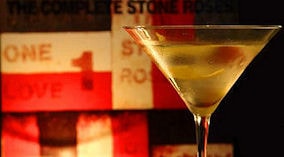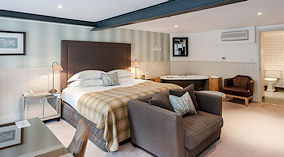Röyksopp

"I guess it’s time to remove the prefix electronic from the discussion of our music. It's just music, isn’t it"?
Svein Berge, one half of Norwegian duo Röyksopp, who’ve experienced massive international success with their very own genre of electronic pop music since the release of their first vinyl single "So Easy" in 1999, looks at his creative partner Torbjørn Brundtland, like he has done so many times before. Ever since childhood, in fact, and as always surrounded by a wild forest of analog synths, wires and modern music equipment. The duality of their music; a little sad and a little happy, dark and humorous, epic and naïve, is reflected in their personalities - they are quite different types, but their personalities are also manifested into one organic unity, with the ability to complete each other's sentences and jokes, and not at least to complement the aesthetic whole of which their musical universe consists.
Their often somewhat quirky but always rather sweet songs have made them into one of the big names in European electronic pop music for the last twenty years, with hits and album releases that have felt like essential events, with some formidable guest vocalists, great remixes for vastly different artists like Depeche Mode, Beck, Lady Gaga and Coldplay, unique music videos that have garnered a lot of attention, a strong visual image and fun and expansive live concerts. Their first four albums all went straight to the top of the charts at home in Norway, and their great popularity in the U.K has contributed to their position as the frontrunners of Scandinavian electronic pop music.
Their music has a lush and imaginative, electroacoustic aura that was unique to them for a long time, but which has had a great global impact on many types of music, from house to pop and psychedelic rock and then back again. One hears echoes of their playful melancholy reverberate in many new artists.
In 2022, they return with their biggest project so far. First with the release of the sparkling single "Impossible", with Alison Goldfrapp on vocals, and then a number of audiovisual experiences that culminate in Profound Mysteries. They publicly said goodbye to the traditional album format with the release The Inevitable End in 2014 in order to work with their music in a more free way in the future, and that is exactly what they are doing now. "It is still important for us to build a kind of house that can accommodate our ideas" says Torbjørn. And it's quite a building they have raised around their songs. The coming year will show exactly how this architecture is conceived.
Röyksopp has always been a conceptually oriented band with moods from vintage film music, ideas from prog rock, melodies from synth pop and a sense of belonging to house and club culture. They can credibly claim that based on this they have created their very own genre, all the time with an eclectic approach and a desire to free themselves from the limitations that music originally created for the dance floor has often struggled with. Genre awareness works well on the dance floor, where you can and should create a concrete atmosphere, and build expectations with structure, drops and so on. But you have to tear and stretch it a bit to make it work outside of that context as well. And that is exactly what Röyksopp has done.
"That was probably where the attraction of synthesizers was for us, right from childhood; few limitations and a wealth of creative possibilities," says Svein. Nevertheless, they have created some limitations for themselves in the creative process. They are still the ones behind all the lyrics and melodies, playing almost all the instruments, as well as mixing sound and producing all the material - in short, they do everything themselves. And those things take time - writing, playing, producing and mixing all the music is an extensive process. But it is also this type of dogma thinking that makes the Röyksopp sound so unique. "The fact that there are only two of us - in every aspect of the process, contributes to a distinct musical expression. The distance from ourselves to the finished product will be very short", says Svein. "In addition, we use - as is well known, a lot of very old analogue equipment. Using this takes time - but at the same time it helps to shape the sonic character of Röyksopp", Torbjørn continues. They do not have this time-consuming approach in order to make their expression and music appear obviously "retro", but rather to put a personal stamp on music that pushes different traditions and life experience into a contemporary context. And that is something that feels essential in a period of time when alot of music sounds similar, because so many people use the same sounds and the same software, as Svein points out. The instrument park has naturally mushroomed over the years and has followed the development of their career and success, but the core is still some synths and samplers which have been with them since they first started making music together in their teens, far up Tromsø in the north of Norway.
Many people might think that Röyksopp was an immediate overnight sensation with the hit single "Eple" in 2001, but actually they had created music together for over ten years before Röyksopp became a unit. They did not have a big plan in the beginning, they were not aware that they were participants in an important music scene that would explode at some point, it was just something that happened.
“Music was just a fun activity we did together. Then we started setting ourselves some small goals, such as scraping together enough money to afford a sampler. Remember that we were 13 -14 years old at the time - in the late 80's, and that the physical process of sampling was something quite different then than it is today", says Svein. "The next thing was to get something released on vinyl, which could be possible by obtaining some obscure names and addresses and phone numbers of small companies in Europe, sending a DAT cassette and then magically ending up picking up a pile of twelve inches at the post office", says Torbjørn.
One might think that it is essential to live in an urban area with credibility to be able to create modern electronic music, house and techno, but growing up in a grey, small town far north, with overwhelming surroundings in nature, gave fertile ground to the imagination and a desire for them to do something else. Boredom has initiated a lot of fun, and should not be underestimated.
There was generally a lot of rock in Norway in the 80’s, the conditions of growth for new electronic music were not the best, the two say today. In primary school, they both had a strong interest in the pioneers of electronic music, as well as science fiction movies such as Star Wars and 2001. It felt logical to connect these expressions to the nature around them. In a child's mind, the sounds of Vangelis, Jean Michel Jarre and Kraftwerk were naturally connected with the huge starry sky above them, with the tripping northern lights and the midnight sun as inspiring, nocturnal special effects. When they also, later in their youth, found a tiny bunch of older people to look up to in Tromsø, such as the group Bel Canto who released music on Crammed Discs in Belgium, and Geir Jenssen who released rather unique music under the name Biosphere on the R&S label, it got a lot easier. Per Martinsen made early Norwegian techno under the name Mental Overdrive, and producer and DJ Bjørn Torske was another important friend to find. Names like this are still key people in the Röyksopp universe, and inseparable parts of the development of Norwegian music.
Svein and Torbjørn's first important recordings in the early 90's were the atmospheric techno project Aedena Cycle together with Kolbjørn Lyslo and Gaute Barlindhaug, with an EP released on R&S. Later, a bunch of them followed alongside colleagues Rune Lindbæk and Ole Mjøs under project names such as Drum Island, Alanïa, and Those Norwegians. The latter without Svein who then served his military service, although the last song on the album Kaminzky Park on Paper Recordings was made by Svein and Torbjørn. Some of it was house music that could certainly have been made in many places, but a lot of international listeners also noticed a certain Arctic, Norwegian touch to other parts of their music. And maybe it was so? They had no need to hide their Norwegian identity.
A new chapter began when in the mid-90’s they followed Bjørn Torske and moved to the city of Bergen on the west coast. Here they met many other, and younger, like-minded, and enterprising people who quickly and organically managed to build a scene. There were several people who lived together in a big flat, and they came up with a common slang and a coded language that made it easy to understand each other creatively, and which also set them apart from everyone else in Norway or anywhere in the world at the time. Eventually people all over talked about «the Bergen wave», even though there was a lot of rather different sounding music in it, from Erot and Kings of Convenience, to Datarock and Annie. Many of these conflicting but spiritually related expressions were collected on the little Tellé label, run by hardcore punk enthusiast Mikal Tellé, today a successful entrepreneur in the music industry.
"Together with Bjørn Torske and Ole Mjøs, we developed a jargon that would describe musical expressions and ideas. Words like swamp, boiled or dirty, became established terminologies, meant to describe the direction of what we wanted to create", says Svein. "That understanding allowed us to do things faster — and that's exactly what we did. Instead of sitting around talking about everything we were going to do, we just did it", Torbjørn continues. The small size of the city made it easy to move around, test out new material out in the clubs, and quickly forge strong bonds with each other. And this was something that was noticed everywhere, not least in the Norwegian capitol of Oslo which was a far less exciting music city at the time.
"It was the right place, the right time, the right people - perfect chemistry", says Torbjørn today.
These activities in the underground soon resonated elsewhere. The Norwegian music industry had long been characterized by an inferiority complex. Luckily this has changed in recent years. Instead of trying to make copies of international successes, which was the industry standard for a long time in Norway, people began to want to create their own thing. "Biosphere was such a thing, black metal was another. We went for a Norwegian-sounding name, but with an international orientation. We wanted to show people who we were. Actively and consciously showing where you come from in an international context, has probably also inspired other Norwegian musicians in retrospect", the boys say modestly.
And the world listened. They were signed by the British label Wall of Sound, which released a lot of funky, hip-hop-influenced club music with a certain historical buzz about it. Singles such as "Eple", and the two songs sung by Erlend Øye: "Remind Me" and "Poor Leno" made the debut album Melody AM (2001) one of that year's defining worldwide releases.
"There are several stages of success. The first sign is when you walk past a store and hear your own music being played inside. You get a small buzz from it. Then you read about yourself here and there. "Watch these guys gain ubiquity" as it was printed in the British fashion magazine The Face, long before it had really taken off”, says Svein. "Then the applause comes from more and more people. Singles take off and the album achieves respect. In our case, it was also crowned by a completely different type of commercial success, which came when Apple and T-mobile and several others wanted to use our music in connection with their products", says Torbjørn. Offers for commercials, film scores, jingles, theatre music and more have been in line since then, right up to the theme song for the evening news on national TV in Norway, but Röyksopp has always been able to make this music on their very own terms.
"It's a very satisfying but also quite ridiculous feeling when you get confirmation that the creative visions you have, all the thoughts and hopes you have had about your own ideas, that they actually come true. It works!", Torbjørn exclaims happily. "For us, some of these activities have been about trying on new things, accepting a challenge and then hopefully manage to expand our horizons", Svein continues. Röyksopp has also shown themselves willing to expand creatively and not get caught up in one idea about how their music should be perceived. They proved this on the more introspective and experimental follow-up album, the masterful LP The Understanding in 2005, and not least with the tandem album releases Junior (2009) and Senior (2010) which was an example of the duality that characterizes the musical DNA of Röyksopp, where the melodic delicacies and the darker, dynamic structures each got their own outlet.
Another characteristic of Röyksopp is their clear sense of being a band. How do you manage that when you're basically engaging in so-called faceless electronic music? Their soundscapes create a sense of belonging, and they have also been able to create a distinct visual profile in their music videos, cover art and graphic design that has had a unifying effect.
"We have always wanted our music to come first. And ourselves in second line”, says Torbjørn. "As people in the public eye, we do not seek a larger presence than is necessary," Svein smiles.
And then we have the elements of classic songwriting on top, with an extensive use of profiled guest vocalists who do not feel added on, who are not ‘featured vocalists’, but who become a natural part of their musical expression, and with whom they have a good vibe with in live shows and touring. Vocalists who understand Röyksopp, and who are tailor made for the songs that they sing on. They become a part of the gang. This applies to the Norwegian singer/songwriter Susanne Sundfør, and Swedish pop stars such as Lykke Li, Karin Dreijer and Robyn (the latter they also made an excellent EP with in 2014 on the successful Do It Again which also featured a joint tour).
"When lyrics and melody are written, it is often with a specific artist in mind. If, for example, I want a melancholy and rather anguished sentiment, it would be natural to ask Susanne Sundfør », Svein smiles.
Röyksopp has also dared to sing a bit themselves, and express during their energetic concerts with many live musicians on stage - and the occasional flamboyant costume - that this is music that is actively made together as a band. The songs of Röyksopp are characterized by strong melodies, whether it is a happy, optimistic ditty or displaying a more dramatic form of beauty. But as their songs are often quite easy to relate to on a sheet of music, what is it then that makes them feel so special?
"For us, texture has always been as central as melody and harmony," says Svein, referring to the gnarled and naturalistic soundscapes that characterizes so many of their tunes. It is a human, what should one call it, skewed and detuned quality in the sounds that makes listeners notice the tunes, and perhaps also thus understand them instinctively, as existence itself may be experienced with all its inaccuracies. It must have been that tiny melodic hiccup in the hit single "Eple" that made people all over feel it more.
“Already in our youth we experimented with what is today called field recordings; using a portable DAT player, we recorded the sound of things like thick snow, boots in wet moss, broken twigs and so on. This was a learning process - we eventually discovered which sounds were useful in our music production, and which were completely worthless to us. For example, you can use some small, abrupt sounds as percussive elements to make a beat. And longer recordings of, for example, the eerie ambience of a forest, can be baked and rubbed into the music. We have many files stored with names like "dark forest" and "thick forest". In general - when Röyksopp talks about texture, they also talk about the impact of nature on their music.
And it is precisely this deep understanding of the mysterious world of people and music and nature that characterizes the sounds and songs of Röyksopp, and that has made them a global phenomenon and one of electronic music's most exciting performers this side of the millennium. Oh, by the way, erase that word electronic. When, after a rather quiet period, they are now ready to step on a lot of creative puffball mushrooms out in the forest with their most extensive project to date, Profound Mysteries, we will again discover from the organic cloud of dust that appears, that only Röyksopp is Röyksopp. When they in 2022 embark on a new chapter in their career and musical oeuvre, they are exploring technology and nature in a similar fashion as in their youthful days in Tromsø, with added profundity.
Röyksopp Tickets
London
Most Popular Shows and Events in London
Here You Come Again - The New Dolly Parton Musical
New Wimbledon Theatre
Tue 18 - Sat 22 Feb 2025
Queen of the Night - A Tribute to Whitney Houston
London Palladium
Fri 14 - Sat 15 Feb 2025
NOW That's What I Call A Musical
New Wimbledon Theatre
Tue 8 - Sat 12 Apr 2025























